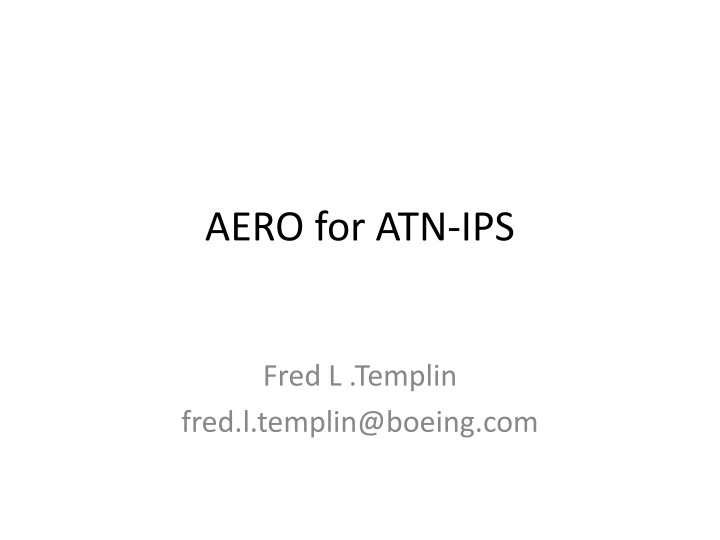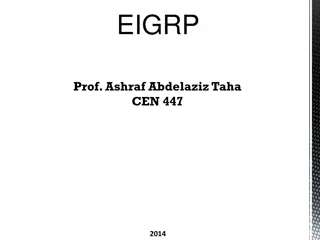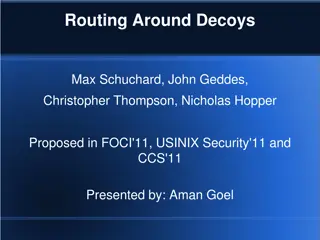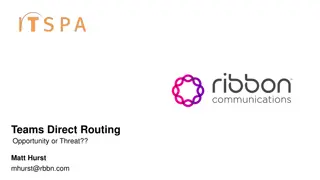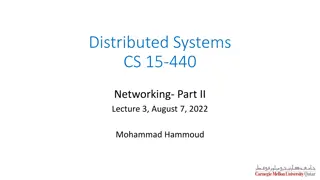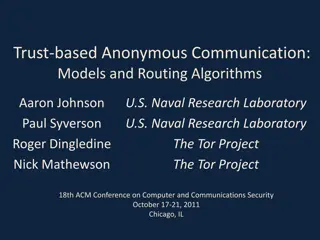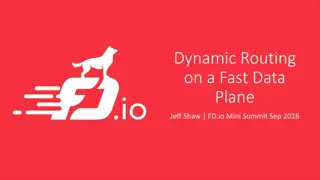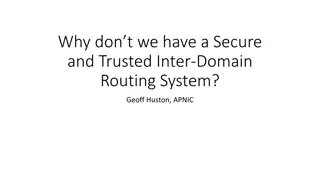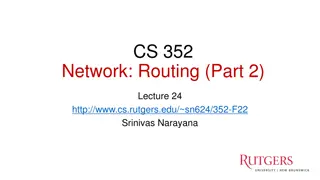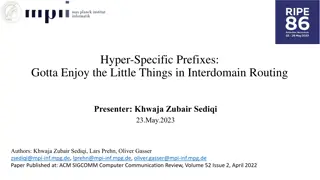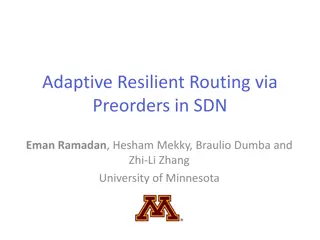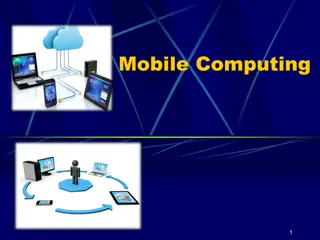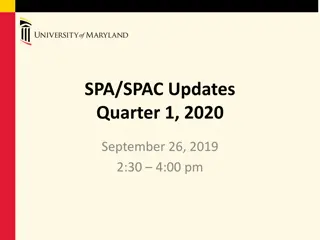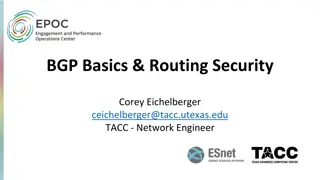AERO: Mobile Routing & Addressing System for IP Internetworks
AERO, Asymmetric Extended Route Optimization, is a mobile routing and addressing system designed for IP internetworks like aviation, enterprise, and campus networks. It enables stable IPv6 prefixes for mobile devices, treating them as routers to connect to the Internet of Things. AERO offers features for security, traffic engineering, and multiple interfaces, making it a versatile platform for various network environments.
Uploaded on Sep 26, 2024 | 1 Views
Download Presentation

Please find below an Image/Link to download the presentation.
The content on the website is provided AS IS for your information and personal use only. It may not be sold, licensed, or shared on other websites without obtaining consent from the author.If you encounter any issues during the download, it is possible that the publisher has removed the file from their server.
You are allowed to download the files provided on this website for personal or commercial use, subject to the condition that they are used lawfully. All files are the property of their respective owners.
The content on the website is provided AS IS for your information and personal use only. It may not be sold, licensed, or shared on other websites without obtaining consent from the author.
E N D
Presentation Transcript
AERO for ATN-IPS Fred L .Templin fred.l.templin@boeing.com
AERO History AERO is Asymmetric Extended Route Optimization Developed in the 2008 2016 timeframe Based on earlier IETF works published as Independent Submission RFCs (RANGER, VET, SEAL, IRON) First Edition published as IETF RFC 6706 Second Edition now an Internet draft (draft-templin- aerolink)
AERO Overview Mobile routing and addressing system for IP Internetworks (e.g., aviation networks, enterprise networks, operator networks, campus networks, etc.) Encapsulation virtual overlay with support for IPv6 End user devices treated as mobile routers to connect an Internet of Things (IoT): Airplanes, cellphones, tablets, laptops, etc. Mobile nodes maintain stable IPv6 prefixes across mobility events Integration platform for security (e.g., VPN), traffic engineering, multiple interfaces, etc.
AERO Aviation Reference Use Case Aircraft as Mobile VPN Client for pervasive secure access over available aviation data links Link management selects links based on flight phase, availability, cost, performance, QoS, etc. Could use multiple links simultaneously AeroMACS, Inmarsat SBB, LDACS, Iridium NEXT, VDL2, cellular, any other IP link Access link IP address can change dynamically, but Aircraft maintains a stable IPv6 prefix for on-board Internet of Things (IoT) Aircraft; controllers as Clients; ground domain nodes as Servers Built-in Route Optimization AERO Client Link Management Aviation data links AERO Server Ground System Devices Air Traffic Control Aeronatuical Telecommunications Network (ATN-IPS)
AERO Virtual Link Model Non-Broadcast, Multiple Access (NBMA) tunnel virtual link Virtual link configured over ATN-IPS global network Clients, Servers and Relays as neighbors on the link Aircraft as mobile Clients; fixed ground domain Servers and Relays IPv6 ND for Route Optimization Relays track Client/Server associations via intra-domainBGP (no BGP updates go to Internet) DHCPv6 PD establishes and manages Client/Server associations No Air-to-Ground dynamic routing protocols (eliminates unnecessary air-to-ground messaging overhead)
AERO LINK Reference Model To the Internet Relay Server Server Server ATN-IPS domain routers AERO Virtual Link Client Client Client Client Client Client Aeronautical Telecommunications Network (ATN-IPS)
AERO DHCPv6 PD All AERO Servers are DHCPv6 servers AERO Clients Request ACP Delegations via DHCPv6 Clients get same ACPs from any Server To the Internet Relay Server Server Server Enterprise network routers AERO Virtual Link fe80::2001:db8:0:1fe80::2001:db8:0:2fe80::2001:db8:0:3 fe80::2001:db8:0:6 fe80::2001:db8:0:4 fe80::2001:db8:0:5 Client Client Client Client Client Client IPS Global Network
AERO Node Mobility AERO Server keeps IPv6 neighbor cache entry for AERO Client Client AERO address is network-layer address Client s access link IP address is link-layer address If Client s link-layer address changes, inform Server with DHCPv6 Rebind Server updates the link-layer address in the neighbor cache entry if Rebind succeeds
AERO Node Mobility DHCPv6 Request registers 192.0.2.1 as Client s first L2 address DHCPv6 Rebind registers 192.0.2.33 as Client s second L2 address DHCPv6 Rebind registers 192.0.2.65 as Client s third L2 address Correspondent Nodes Server Internetwork 2001:db8:0:2::/64 2001:db8:0:3::/64 fe80::2001:db8:0:2 AERO Virtual Link fe80:: fe80::2001:db8:0:3 192.0.2.65 192.0.2.1 192.0.2.33 fe80::2001:db8:0:1 2001:db8:0:1::/64 Mobile Node
AERO Architecture AERO Client Prefixes (ACPs) ACPs not exposed to Internet Clients get unique LL addresses via AERO address format Distributed Mobility Management Non-Broadcast Multiple Access (NBMA) tunnel virtual link configured over ATN or other Internetwork All nodes on the link are single-hop neighbors IPv6 ND works the same as for any link Clients associate with Servers via DHCPv6 PD Relays and Servers use interior BGP Instance to track Archetype for MIP/PMIP is a mobile host associated with a home link Archetype for AERO is a mobile router associated with a home network To Internet Relays BGP Internetwork Servers AERO Virtual Link Clients
AERO Route Optimization First packet and IPv6 ND Predirect to Server Server forwards Predirect ; triggers IPv6 ND Redirect Subsequent packets go directly to target (route optimization) Standard IPv6 ND NUD to test reachability Standard IPv6 ND to announce link-layer address change Relays and Servers Internetwork AERO Virtual Link fe80:: NA AERO Addresses NS fe80::2001:db8:0:1 fe80::2001:db8:0:2 fe80::2001:db8:0:3 Clients Clients NA 2001:db8:0:1::/64 2001:db8:0:2::/64 2001:db8:0:3::/64
AERO Intra-Network Mobility Client C1 moves from access link A1 to access link A2 within the same Internetwork C1 sends IPv6 ND message to Client C2 with new link-layer address from A2 C2 updates ncache entry for C1 the same as for link-layer address change on any IPv6 link This is a micro-mobility event no BGP updates If C1 moves far from its current Server S1, it sends DHCPv6 PD Request to new Server S2 and DHCPv6 PD Release to old Server S1 A macro-mobility event S1; S2 send BGP updates
AERO Internet-Wide Mobility Client A sends Predirect message through home network (similar to MIP Home Test Init ) and sends Predirect through Internet (similar to MIP Care-of Test Init ) Client B sends Redirect messages to Client A s home address and Internet address (similar to Home Test / Care-of Test) Client A sends NS to Client B (similar to Binding Update) Client B sends NA to Client A (similar to Binding Ack) Route optimization in forward direction A->B (asymmetric) If A moves, sends new NS to B AERO Link B Internet Security Gateway AERO Link A Security Gateway Client B Client A
Proxy AERO AERO Clients become fixed infrastructure the same as for AERO Servers, Relays Clients analogous to PMIP MAG; Servers analogous to PMIP LMA Mobile nodes associate with Clients via IPv6 ND; link- layer join/leave (same as for PMIP) When a MN comes on a Client s access link, Client issues new DHCPv6 PD Client will have many ACPs and many AERO addresses; one for each mobile Fast handovers coordinated roughly the same as for Fast PMIP, but simpler (see draft)
AERO Capability Discovery If correspondent node uses same AERO Service Prefix (ASP), Internetwork and Internet-wide Route Optimization supported If candidate correspondent node has the ACP 2001:db8:2::/64, perform DNS lookup for: 0.0.0.0.2.0.0.0.8.b.d.0.1.0.0.2.aero.linkupnetworks.net If DNS lookup succeeds, correspondent is an AERO node in a different home network
AERO Control/Forwarding Plane Separation Client associates with Server via DHCPv6 PD as usual Server updates Forwarding Agent (NETCONF, BGP, etc.) Client sends initial packets through Server Server returns IPv6 ND RA message with SLLAO containing link-layer address of Forwarding Agent Client sends subsequent packets through Forwarding Agent Correspondent Forwarding Agent Internetwork Server AERO Virtual Link RA Client
Summary AERO is an IP mobility solution for ATN-IPS Each AERO Client is an IPv6 mobile network Clients can be airplanes, ground controllers, any other ATN-IPS correspondent AERO treats the ATN-IPS infrastructure as an NBMA link-layer for route optimization AERO and MIPv6 address similar requirements, but with different mobility archetypes: AERO is a mobile router associated with a home ATN MIPv6 is a mobile host associated with a home subnet
AERO Use Cases AERO for enterprise mobile device users iPad, iPhone, Android, Windows mobiles Goal: place AERO handsets with corporate users AERO for civil aviation: Airplane as mobile router for its attached networks On-board device addresses remain stable as aircraft travels Goal: effective Air Traffic Management AERO for other uses: numerous other use cases under investigation
AERO Innovations New IPv6 link-local Address Format (the AERO Address) IPv6 delegated prefix is 2001:db8:1:2::/64 AERO link-local address is fe80::2001:db8:1:2 Address and prefix do not change as node moves AERO route optimization Uses network trust anchors as intermediaries Fully supports mobility (mobile networks and routers) Works over any IPv4 or IPv6 access technologies (e.g., Ethernet, 3G/4G, WiFi, aeronautical links, MANET links, etc.) AERO Routing System Servers manage collections of mobile Clients BGP routing between Servers and Relays Relays connect AERO link to rest of Internetwork
AERO DHCPv6 Service Model All AERO Servers are also DHCPv6 Servers All AERO Servers have common table of Client ID to AERO Client Prefix (ACP) mappings AERO Clients get ACP delegations through DHCPv6 PD via a nearby Server AERO Clients get the *same* ACP regardless of which Server they associate with AERO Clients can Request the same ACP via multiple Servers Prefix Delegation adds Neighbor Cache Entry for Client<->ACP binding
DHCPv6 Security AERO Server is critical infrastructure trust anchor for AERO Client (Client does not need to authenticate Server) AERO Client authenticates itself to the access network (e.g., IEEE 802.1x) then issues DHCPv6 Request to get Prefix Delegation AERO Server needs some way to know Client is authorized to use its claimed Client ID (DUID) DHCPv6 Auth? not widely used; weak Secure DHCPv6? looks promising
AERO LINK Reference Model .-(::::::::) .-(:::: IP ::::)-. +-----------+ (:: Internetwork ::) | DHCPv6 | `-(::::::::::::)-' | Server D | `-(::::::)-' +-----------+ | +--------------+ +------+-------+ +--------------+ |AERO Server S1| | AERO Relay R | |AERO Server S2| | (default->R) | | (A->C; G->E) | | (default->R) | | (A->B) | +-------+------+ | (G->F) | +-------+------+ | +------+-------+ | | | X---+---+-------------------+------------------+---+---X | AERO Link | +-----+--------+ +--------+-----+ |AERO Client B | |AERO Client C | | default->S1) | | default->S2) | +--------------+ +--------------+ .-. .-. ,-( _)-. ,-( _)-. .-(_ IP )-. .-(_ IP )-. (__ EUN ) (__ EUN ) `-(______)-' `-(______)-' | | +--------+ +--------+ | Host D | | Host E | +--------+ +--------+
Old AERO DHCPv6 Service Model All AERO Servers are also DHCPv6 relays AERO Servers pass Client DHCPv6 PD requests to a centralized DHCPv6 server DHCPv6 server delegates AERO Client Prefix (ACP) AERO Server snoops PD and caches Client<->ACP binding (similar to old DHCPv6 RAAN option) Problematic if Client needs to move to a new AERO Server (no way of telling old Server goodbye ) Does not allow Client to associate with multiple Servers
AERO DHCPv6 PD (old model) Single DHCPv6 Server; AERO Servers as DHCPv6 relays DHCPv6 server delegates prefixes Clients configure link-local AERO address DHCPv6 Server Relays and Servers Internetwork AERO Virtual Link fe80:: AERO Addresses fe80::2001:db8:0:1 fe80::2001:db8:0:2 fe80::2001:db8:0:3 Clients Clients 2001:db8:0:1::/64 2001:db8:0:2::/64 2001:db8:0:3::/64
AERO Advanced Topics DHCPv6 Service Model and IPv6 link-local address forming IPv6 Neighbor Discovery mobility signaling AERO mobility scenarios (intra-network, Internet-wide, proxy AERO) AERO correspondent node capability discovery AERO Control/Forwarding Plane Separation
